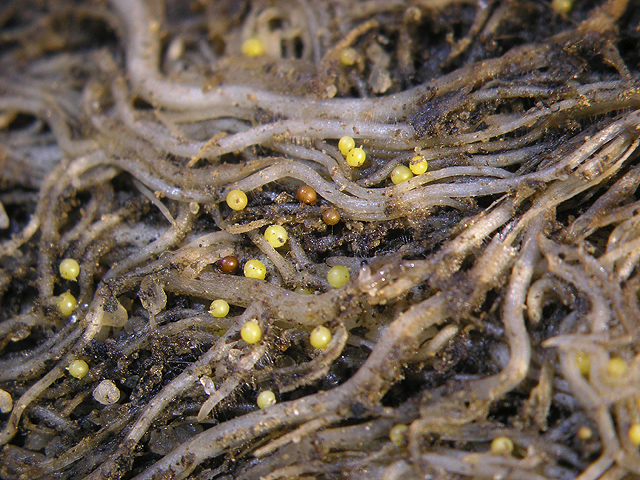
Exercise 14
NEMATODE DISEASES IN PLANTS
Plant parasitic nematodes are microscopic, multi-cellular, eel-shaped, un-segmented worms, ranging from 0.25 mm to > 1.0 mm in length (with some up to 4.0 mm). They may be endoparasites as well as ectoparasites. At maturity, females of some species lose their worm-like shape, enlarge, and may become pear, lemon or kidney-shaped. Plant parasitic nematodes (PPN) have a specialized feeding structure, the stylet or spear, which is used for injecting enzymes into plant cells and tissues, and then for the extraction of contents from the tissues.
The major PPN are: root knot nematode (Meloidogyne spp.), cyst-forming nematode (Heterodera spp., Globodera spp.), citrus nematode (Tylenchulus semipenetrans), gall-forming nematodes (Anguina spp.), root-lesion nematodes (Pratylenchus spp.) and bulb and stem nematodes (Ditylenchus spp.).
Materials
- Spade
- Hand towel
- Soil digger
- Knives (for cutting roots), scissors, polythene sample bags, tags, extraction trays and sieving sets.
Procedure
- The stages in nematode assessment
Stage 1: Visit the nearby fields, look for nematode symptoms and assess the damage.
Stage 2: Collect soil and plant tissue samples.
Stage 3: Extract nematodes from soil or root samples using modified Baermann technique or Whitehead tray method.
Stage 4: Identification of nematodes.
Stage 5: Assessment of nematode density.
- Major symptoms of Nematodes
Root knot:Characterized by galls on the roots. e.g. Meloidogyne spp.
Nurse cells:These are multinucleate syncytium upon which nematodes feed. These are formed in pericycle and endodermal cells of the plant. e.g. Tylenchulus semipenetrans.
Cyst formation:In cyst nematodes, the female lays 200 to 400 eggs in a yellow gelatinous matrix forming an egg sac which remains inside the tissues. After that, female dies and egg sac gets hardened forming a cyst. Example of cyst forming nematode isHeterodera glycines.
Questions
- What is stylet?
It is the piercing structure of the nematodes through which nematodes cause injury in the tissues of the plant. All parasitic nematodes have stylet.
- What is mode of spread of ear cockle disease of wheat?
Infected grains present in the infected spikes is the real cause of the spread of this disease.
- Can nematodes be cultured on artificial medium?
- How will you differentiate between galls and nodules?
Galls are formed from the infection of bacteria and nematodes, and are produced because of infection of the pathogen while nodule are produced by beneficial bacteria and help the legumes plants to convert nitrogen into nitrates and in this soil fertility increases.


